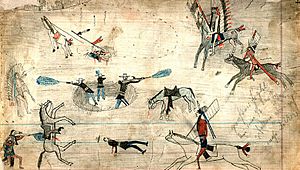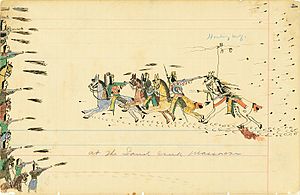Ledger art facts for kids
Ledger art is a special kind of drawing or painting. It was mostly made by Plains Indians, but also by people from the Plateau and Great Basin areas. These artworks tell stories on paper or cloth. Ledger art was very popular from the 1860s to the 1920s. It became popular again in the 1960s and 1970s. The name "ledger art" comes from the accounting ledger books. These books were a common source of paper for Plains Indians in the late 1800s.

Contents
How Ledger Art Started
Ledger art grew out of an older tradition called Plains hide painting. For Plains tribes, women usually painted abstract designs. These designs were seen on items like parfleches (storage containers). Men, on the other hand, painted pictures of things. These pictures were often special symbols or visions. They were painted on shields, tipis, shirts, leggings, or robes.
Before Plains tribes had to live on reservations in the 1870s, men often painted their own brave actions. These included feats in battle or hunting. Plains ledger art showed important events that everyone in the community knew about. These events helped individuals, their families, and their tribe gain respect. Plains picture art focuses on the story. It leaves out extra details or backgrounds. Figures were usually drawn with strong outlines and filled with solid colors.
Historically, these story-telling artworks were painted on animal hides. Buffalo hides were especially common. But when buffalo became rare, artists started using paper, canvas, and muslin. This happened after the U.S. government's programs to reduce buffalo numbers.
What Ledger Art Shows
Battle stories were a main topic in ledger art. Other common subjects included hunting, courtship (people trying to find a partner), and religious practices. Ledger artists also drew about their changing world. They showed European Americans arriving and new things like trains and cameras.
Many ledger artists worked with experts who study cultures (ethnologists). They drew shield and tipi designs, plant information, winter counts (historical records), dance customs, and special clothing. Dreams and visions also inspired ledger art, just like they had inspired earlier hide paintings.
Today, artists who create ledger art often show life before reservations. They also show historical changes and comment on society. They use this art style to connect past Native life with today's life.
New Art Supplies
More ledger books and other paper became available. They came from traders, government agents, missionaries, and military officers. Along with paper came new tools. These included pencils, ink pens, crayons, and watercolor paints. These new tools allowed artists to add more detail and try new things. Older tools, like bone or wood sticks dipped in mineral colors, were more basic. The small ledger books and pencils were easy to carry. This made them perfect for people who moved around a lot.
Artists Working Together
Sometimes, more than one artist worked on a single ledger drawing. Several artists might even work in the same ledger book. Many early ledger drawings had several artist signatures. This suggests that artists shared the work. For example, in the Dog Soldiers ledgers, drawings by Bear with Feathers often show that he drew the people. But another artist drew the horses. In 1877, a Northern Arapaho man named Friday said that it was "very common" for close friends to draw in each other's books.
Fort Marion Artists

Some famous ledger artists were prisoners of war at Fort Marion in St. Augustine, Florida. In 1874, a group of Cheyenne, Kiowa, and Comanche warriors fought the U.S. Army. This was called the Red River War. They fought to protect the last free buffalo herds and keep their independence. In the hard winter of 1874 to 1875, many tribal camps had to surrender. The supposed leaders of the Red River War were gathered up and sent to Fort Marion.
From 1875 to 1878, 71 men and one woman were held there. They were under the command of Richard Henry Pratt. He used this chance to give the Native Americans a Western education. He also gave the prisoners art supplies. These included pencils, ink, crayons, watercolor paint, and paper.
Twenty-six of the Fort Marion prisoners started drawing. They were younger Cheyenne, Arapaho, and Kiowa men. Some of the most well-known artists were Paul Caryl Zotom (Kiowa), David Pendleton Oakerhater (Cheyenne), Tichkematse (Cheyenne), Wohaw (Kiowa), Howling Wolf (Cheyenne), and Etahdleuh Doanmoe (Kiowa). Many of them continued drawing after they were released from prison.
Cheyenne Dog Soldier Art
After a battle in July 1869 at Summit Springs in Colorado, a ledger book was found in a burned Cheyenne village. A soldier wrote in the book: "This book was captured by the Fifth U.S. Cavalry on their charge through the Indian Village July 10th 69." These drawings are known as the Summit Springs Sketchbook. They show events and people from 1864 (Sand Creek massacre) to 1869 (Battle of Summit Springs).
Selling Ledger Art
In the 1900s and early 2000s, many ledger books were taken apart. The individual drawings were sold by art galleries and auction houses. They became "hot items in the art market," costing tens of thousands of dollars per drawing. When the drawings were sold page by page, the original story order of the books was lost. This also happened after drawings were stolen, found, or given away by non-Native people. This meant the "completeness of the full ledger book" was lost.
This selling of art started in the late 1800s. Colonel Richard Pratt, who started the Carlisle Indian Industrial School, taught the Fort Marion prisoners about business. Artists like Zotom and Howling Wolf were trained to create drawings for "wealthy white patrons." This was part of his effort to make the prisoners adopt Western ways.
Modern Ledger Art
Missionaries, anthropologists (people who study human cultures), and tourists eagerly collected ledger books in the late 1800s. Carl Sweezy (Southern Arapaho, 1881–1953) and Haungooah (Kiowa, 1860–1940) both became professional ledger artists.
These early Southern Plains artists inspired a group called the Kiowa Six. These artists used Western art materials. They became famous around the world when they showed their work in Prague, Czechoslovakia, in 1928.
Famous Ledger Artists
Historical Artists
- Amos Bad Heart Bull, Oglala Lakota
- Black Hawk, Sans Arc Lakota
- Howling Wolf (Cheyenne)
- Jaw (Ćehu′pa) or His Fight (Okicize Tawa) (around 1853-1924), Hunkpapa Lakota
- Red Horse (Lakota chief), Lakota, made 42 drawings about the Battle of the Little Bighorn
- St. David Pendleton Oakerhater, Southern Cheyenne
- Silver Horn, Kiowa
- Sitting Bull, Hunkpapa Lakota
- White Horse, Kiowa
- Yellow Nose, Ute
Today's Artists
- Sharron Ahtone Harjo (Kiowa)
- Arthur Amiotte (Oglala Lakota)
- Sherman Chaddlesone (Kiowa, 1947–2013)
- Chris Pappan (Kaw/Osage/Cheyenne River Lakota)
- Harvey Pratt (Cheyenne-Arapaho Tribes)
Images for kids







